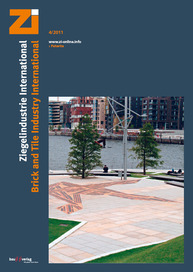For 2010 Wienerberger AG has reported the following figures: group revenues fell by 4% to
€ 1 744.8 mill., the operating EBITDA reached € 210.8 mill. and, thanks to cost savings and better capacity utilization, was slightly better than the prior-year figure. Earnings before interest and tax (EBIT) rose significantly from € -258.1 mill. in 2009 to € 10.7 mill. Financial results decreased in 2010. After the deduction of € -51.5 mill. in financial results and the addition of € 5.9 mill. in taxes, the after-tax loss amounted to € 34.9 mill. compared with € 258.7 mill. in 2009, when restructuring costs had a strong negative impact on earnings.
Gross cash flow amounted to € 151.3 mill., or roughly € 100 mill. more than in 2009, while cash flow from operating activities reached € 230.4 mill. A total of € 149.8 mill. was used for investments, with € 61.7 mill. for maintenance and € 88.1 mill. for the completion of previously started projects and smaller acquisitions.
Optimization of Wienerberger holdings
Following the takeover of the Steinzeug Group in October 2010, Wienerberger subsequently acquired the remaining 25-% stake in the concrete paver specialist Semmelrock and now holds 100% of this company. The roof segment investments were also restructured through a stock swap with Monier in January 2011. Wienerberger transferred its 50-% stake in the concrete tile producer Bramac to the former joint venture partner Monier and received a further 25% in Tondach Gleinstätten plus a settlement payment. Wienerberger will then own 50% of Tondach.
Outlook and strategy
Wienerberger is not in the position to provide a specific guidance for 2011 at the present time because visibility in two key regions – Eastern Europe and the USA – is still very limited. Heimo Scheuch, CEO of Wienerberger AG, commented: “I am generally optimistic for 2011, since I expect stable to slightly positive development on all West European markets and a moderate increase in the demand for bricks. I estimate a recovery in US new residential construction will only be possible during the second half-year. The markets in Central-East Europe are also difficult to judge. Poland, with its strong domestic demand, is the only country in the region that gives me grounds for optimism in 2011, because of a stable to slightly positive development in the demand. Visibility is so low in the other East European countries that I cannot make any predictions and would also not exclude a further slight decline in demand.”
Wienerberger expects a slight increase in input costs for 2011, especially for energy. More than half of the required quantities of gas and electricity have already been secured through fixed price contracts on the energy markets. Taking into account possible price increases in the uncovered requirements a price-related increase of approx. € 15 mill. in energy costs is possible.

